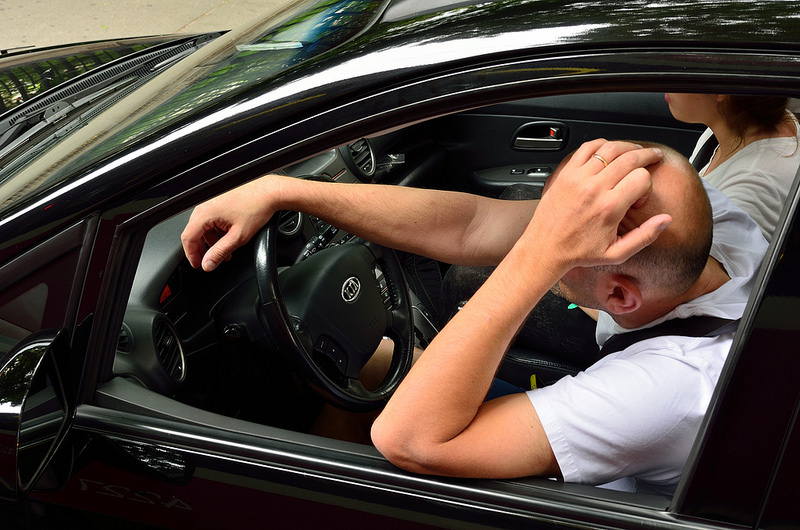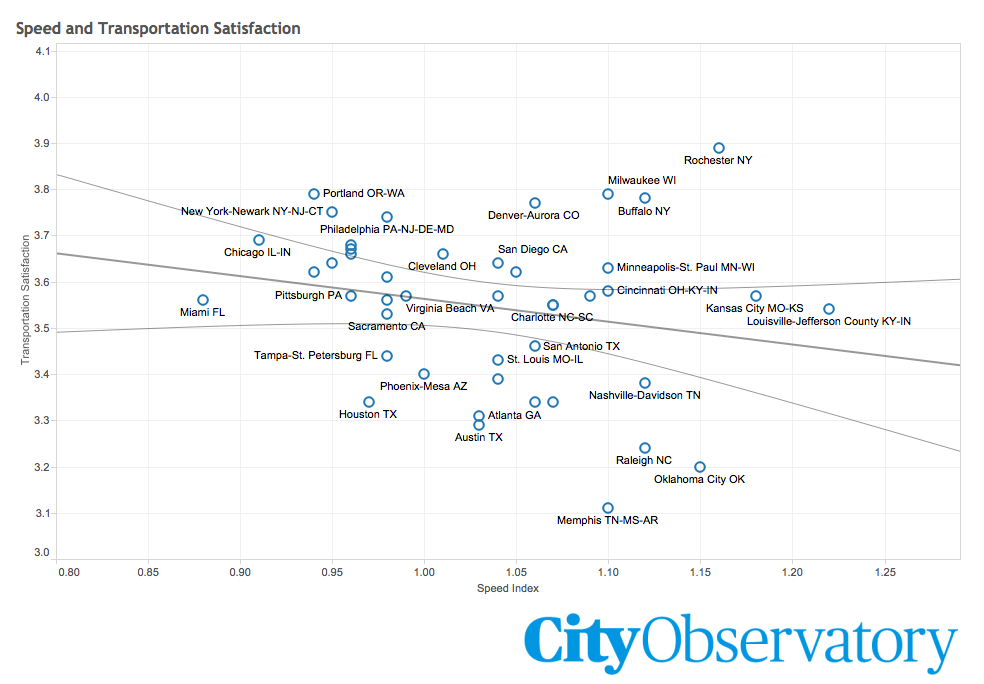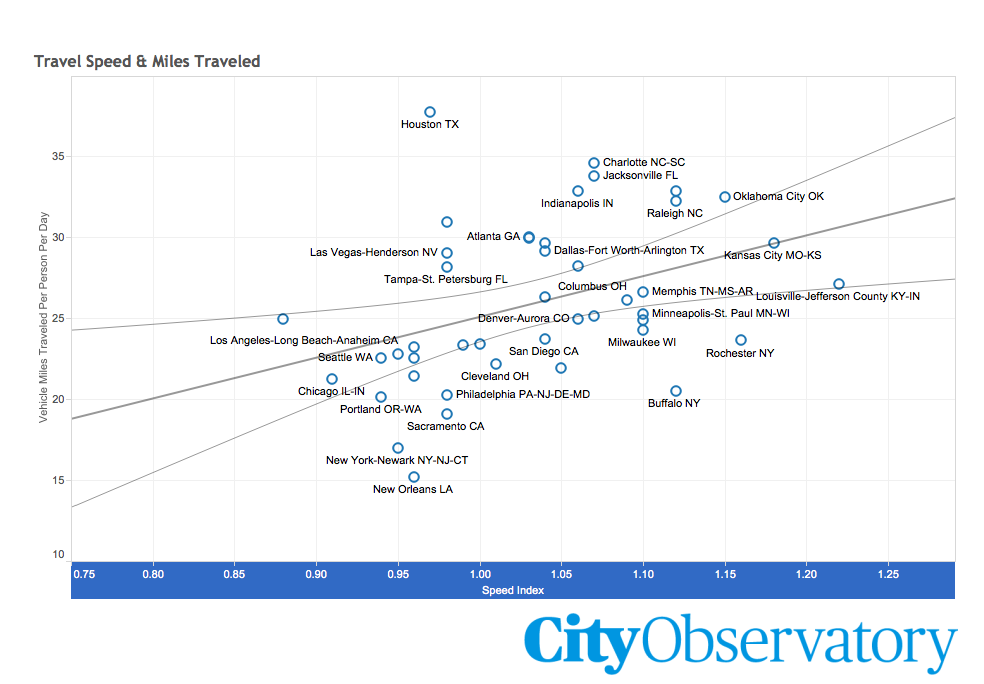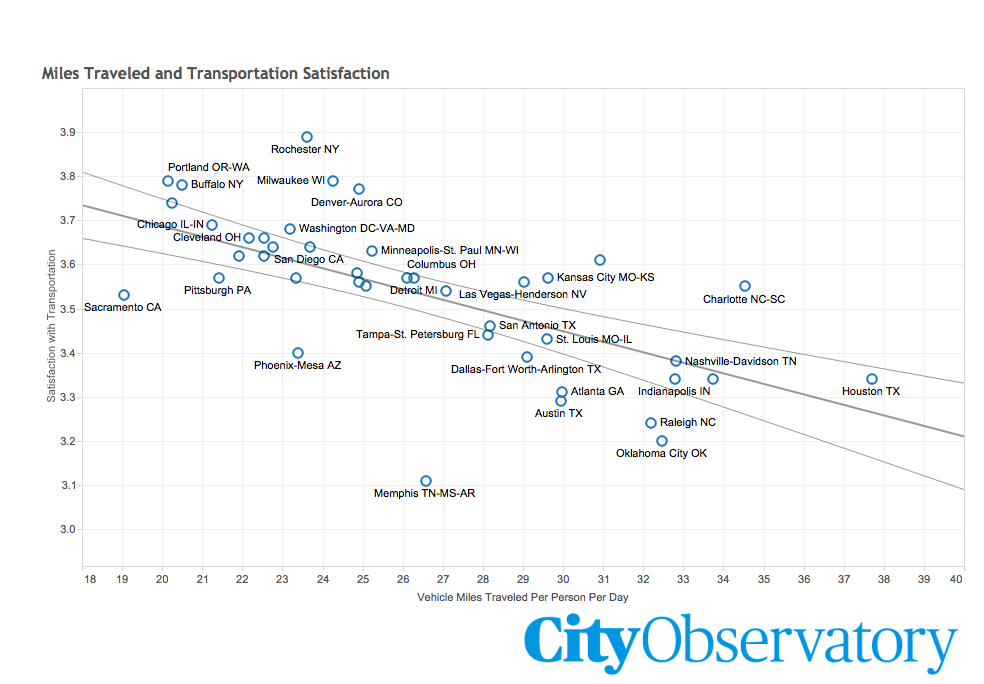Speed doesn’t seem to be at all correlated to how happy we our with our local transportation systems.
If there’s one big complaint people seem to have about the transportation system its that they can’t get from place to place as quickly as they like. TV traffic reporters are always alerting us to delays; Google and Waze are giving us advice on quicker routes, and transportation departments are always promising that some big new project will speed traffic. But that leads us to consider a pretty basic question: Does going faster make us happier. The short answer is no; the longer answer is more complicated (but is also “no.”)
Some time ago, we unearthed some interesting estimates of the average speed of travel in different metropolitan areas developed by the University of California’s Victor Couture. His data shows that average travel speeds in some metropolitan areas (like Louisville) are 22 percent faster than in the typical large metro area; while in other areas they are slower. Miami’s speeds average about 12 percent less than the typical metro. We’ve long assumed that one of the goals of our transportation system is to enable us to move as quickly as possible when we travel, so it stands to reason that the people who live in “faster” cities ought to be happier with their transportation systems.

To test that hypothesis, we had a look at some survey data generated by real estate analytics firm Porch. They commissioned a nationally representative survey of residents of the nation’s large metropolitan areas and asked them how they rated their satisfaction with their local transportation system on a scale of 1 to 5, with 5 being very satisfied. We compared these metro level ratings of satisfaction to Couture’s estimates of relative speeds in each metro areas. There’s a bit of a time lag between the two data sources: the survey data is from 2015 while the speed data is from 2008; but as we showed yesterday, the 2008 speed data correlates closely with an independent study of traffic congestion levels in 2016, suggesting that the relative performance of city transportation systems hasn’t changed much in that time period.
Faster Metros don’t have happier travelers
The following chart shows happiness with the regional transportation system on the vertical axis, and average speed on the horizontal axis. Higher values on the vertical (happiness) scale indicate greater satisfaction; larger values on the horizontal (speed) scale indicate faster than average travel speeds. The data show a weak negative relationship that falls short of conventional significancel tests (p = .16). While there isn’t a strong relationship between speed and happiness, if anything it leans towards being a negative one; those who live in “faster” cities are not happier with their transportation system than those who live in slower ones.

We have a strong hunch as to why traveling faster might not generate more satisfaction with the transportation system. Faster travel is often correlated with lower density, and longer travel distances to common destinations, such as workplaces, schools and stores. If you have a sprawling, low density metropolitan area, with great distances between destinations, much of the potential savings in travel time may be eaten up by having to travel longer distances. A complementary explanation is that places with faster speeds, may be ones where proportionately more travel occurs on higher speed, higher capacity roads, such as freeways, parkways and major arterials, as opposed to city streets. The higher measured speed may a product of traveling long distances at high speeds in some cities, as opposed to cities with much shorter average trips on slower city streets.
Faster travel is correlated with more driving
To explore this hypothesis, we compared average vehicle miles traveled (VMT) per person per day, as reported by the US Department of Transportation, to the average estimated speeds for metropolitan areas. Both of these sets of observations are for 2008. The following chart shows VMT per capita on the vertical axis and average speed on the horizontal axis. As we thought, there’s a strong positive relationship between speed and distance traveled. People who live in places with faster speeds drive more miles per day.

More driving is associated with less satisfaction with metro transportation
To tie this all together, we thought we’d look at one more relationship: How does distance traveled affect happiness with an area’s transportation system? This final chart shows the happiness (on the vertical axis) and vehicle miles traveled (on the horizontal axis). Here there is a strong negative relationship: the further residents drive on a daily basis, the less happy they are with their metro area’s transportation system.

We think this chart has an important implication for thinking about cities and transportation. Instead of focusing on speed, which seems to have little if any relationship to how people view the quality of their transportation system, we ought to be looking for ways to influence land use patterns so that people to have to travel as far. If we could figure out ways to enable shorter trips and less travel, we’d have happier citizens.
